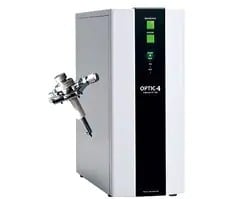Samples are pipetted directly into the GC injection port using a needle. Analytes are usually derivatized to lower their boiling point, allowing the sample to be injected at a lower temperature.
Guide de sélection des systèmes d'introduction d'échantillons GCMS
Choosing a Sample Introduction Technique for GC/MS Analysis
This page provides a quick overview of sample introduction methods for analysis with gas chromatography-mass spectroscopy. It also indicates the Shimadzu GC/MS autosamplers compatible with each method. For a more detailed explanation, download our pdf guide.
Contents
1. What sample introduction techniques are available for GC/MS analysis?
Here we briefly describe the eight main techniques for GC/MS sample pretreatment and introduction.
-
-
Samples are pre-heated within the autosampler. More volatile components converge in the gas headspace, which is then sampled and injected into the GC.
-
Also known as “purge and trap”. Inert gas is introduced into the liquid sample to “purge” it. The volatile analytes are swept into an absorbent trap connected to the sample vial. The trap is then heated, releasing the analytes into the GC-MS system.
-
A portable sampling pump is used to collect field samples of gas in thermal desorption (TD) tubes filled with trap sorbents. Heating the tubes releases volatile analytes into the GC-MS using an adsorbent trap system.
-
Unlike the TD method above, the TD tubes are filled directly with solid samples. Heating the tubes releases volatile analytes, which may be introduced directly into the GC or pass through a trap sorbent.
-
A specialized SPME needle is injected directly into liquid samples or into a sample headspace for adsorption of analytes. The needle is then inserted into the pre-heated injection port and releases the analytes through heat desorption.
-
Small solid or liquid samples are placed in a small cup, which is attached to a heating probe and inserted directly into the ionization chamber without passing through a GC column. The sample is ionized through heating.
-
Used for less volatile or non-volatile compounds in liquid or solid samples. The sample is rapidly heated to 600-1000℃, releasing smaller, more volatile decomposition products that can then be separated and analysed by GC-MS.
Summary table
| Technique | Matrix | Target analytes | Shimadzu's GC/MS accessories | |
|---|---|---|---|---|
| Liquid injection (Liq) | Liquid (no sample prep) | Volatile or semi-volatile | AOC-30 series | AOC-6000 Plus series |
| Static headspace (SHS) | Liquid, (semi-)solid | Volatile | HS-20 NX series | |
| Dynamic headspace (DHS) | Liquid, (semi-)solid | Volatile | HS-20 NX Trap model | |
| Solid phase microextraction (SPME) | Gas, liquid, (semi-)solid | Volatile or semi-volatile | ||
| Thermal desorption (TD) | Gas, liquid, (semi-)solid | Volatile or semi-volatile | TD-30 series | OPTIC-4 |
| Direct thermal desorption(D-TD) | Liquid, (semi-)solid | Volatile or semi-volatile | EGA/PY-3030D | TD-30 series |
| Pyrolysis (Py) | Liquid, (semi-)solid | Less volatile, non-volatile | OPTIC-4 | |
| Direct sample injection (DI) | Liquid, (semi-)solid | Less volatile, non-volatile | DI-2010 | |
2. How does sample volatility affect the choice of technique?
Sample volatility is a key factor in selecting a sample introduction technique.
This chart shows the boiling points of various compound groups and the most suitable introduction methods over different volatility ranges.
3. How do sample matrices affect the choice of technique?
The figure below shows the most appropriate technique taking into account both sample volatility and the matrix interference. Analysis is difficult when the sample and its matrix have similar volatility.
4. What is the sensitivity range for each technique?
Below is the general sensitivity range for each technique. All of these techniques can be used for trace-level analysis when paired with a high-sensitivity MS detector.
| Technique | Sensitivity | Shimadzu's GC/MS accessories | |
|---|---|---|---|
| ppb~ppm level | |||
| ppt~ppb level | |||
| ppt~ppb level | |||
| ppt~ppb level | | ||
| ppt~ppm level | |||
| ppb level | |||
| μg level | | ||
| ng level | |||



.jpg)

.jpg)




